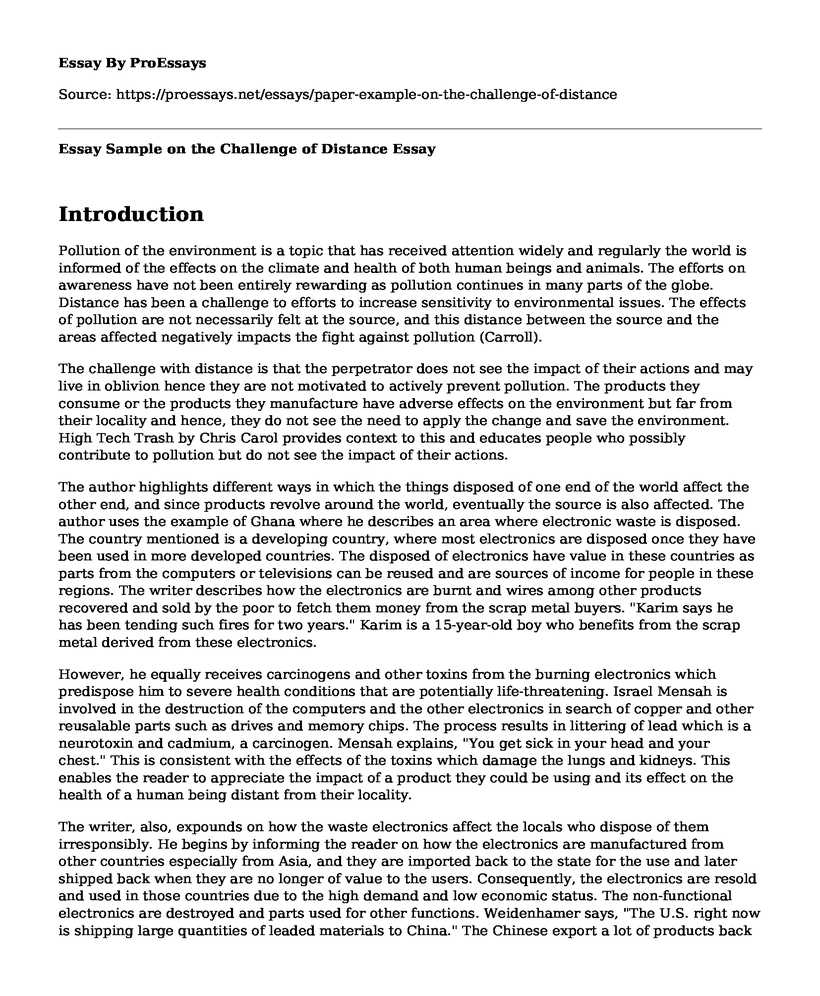Introduction
Pollution of the environment is a topic that has received attention widely and regularly the world is informed of the effects on the climate and health of both human beings and animals. The efforts on awareness have not been entirely rewarding as pollution continues in many parts of the globe. Distance has been a challenge to efforts to increase sensitivity to environmental issues. The effects of pollution are not necessarily felt at the source, and this distance between the source and the areas affected negatively impacts the fight against pollution (Carroll).
The challenge with distance is that the perpetrator does not see the impact of their actions and may live in oblivion hence they are not motivated to actively prevent pollution. The products they consume or the products they manufacture have adverse effects on the environment but far from their locality and hence, they do not see the need to apply the change and save the environment. High Tech Trash by Chris Carol provides context to this and educates people who possibly contribute to pollution but do not see the impact of their actions.
The author highlights different ways in which the things disposed of one end of the world affect the other end, and since products revolve around the world, eventually the source is also affected. The author uses the example of Ghana where he describes an area where electronic waste is disposed. The country mentioned is a developing country, where most electronics are disposed once they have been used in more developed countries. The disposed of electronics have value in these countries as parts from the computers or televisions can be reused and are sources of income for people in these regions. The writer describes how the electronics are burnt and wires among other products recovered and sold by the poor to fetch them money from the scrap metal buyers. "Karim says he has been tending such fires for two years." Karim is a 15-year-old boy who benefits from the scrap metal derived from these electronics.
However, he equally receives carcinogens and other toxins from the burning electronics which predispose him to severe health conditions that are potentially life-threatening. Israel Mensah is involved in the destruction of the computers and the other electronics in search of copper and other reusalable parts such as drives and memory chips. The process results in littering of lead which is a neurotoxin and cadmium, a carcinogen. Mensah explains, "You get sick in your head and your chest." This is consistent with the effects of the toxins which damage the lungs and kidneys. This enables the reader to appreciate the impact of a product they could be using and its effect on the health of a human being distant from their locality.
The writer, also, expounds on how the waste electronics affect the locals who dispose of them irresponsibly. He begins by informing the reader on how the electronics are manufactured from other countries especially from Asia, and they are imported back to the state for the use and later shipped back when they are no longer of value to the users. Consequently, the electronics are resold and used in those countries due to the high demand and low economic status. The non-functional electronics are destroyed and parts used for other functions. Weidenhamer says, "The U.S. right now is shipping large quantities of leaded materials to China." The Chinese export a lot of products back to the United States and some including ornaments are leaded and this risks the health of the citizens.
Conclusion
The distance challenge is adequately addressed when the reader discovers from the information provided that the electronics they disposed of are reused, and the toxic components find their way back to the country and informs that expose them to health risks. The realization that the waste they dispose of could hurt an individual at a distance and eventually hurt them motivates the reader to develop habits that promote proper waste management and prevent pollution of the environment and injury to the health of other human beings.
Works Cited
Carroll, Chris. "HIGH-TECH TRASH." NATIONAL GEOGRAPHIC (2018).
Cite this page
Essay Sample on the Challenge of Distance. (2022, Oct 18). Retrieved from https://proessays.net/essays/paper-example-on-the-challenge-of-distance
If you are the original author of this essay and no longer wish to have it published on the ProEssays website, please click below to request its removal:
- Coastal Community Studies: Rockaway and Long Beach, New York after Hurricane Sandy
- Essay Example on Invasive Species: Kudzu, Pampas Grass, Star-Thistle
- Essay Example on Marine Ports: Pollution & Health Risks
- Analysis of Waste Mgmt: 6 Pillars & Moral Philosophies - Essay Sample
- Essay Example on Atmospheric States of the World: The North Atlantic Oscillation
- Report Example on Environmental Movement
- Exploring Global Issues: A Guide to Individual Oral Presentations and Portfolio Reflections - Free Paper







